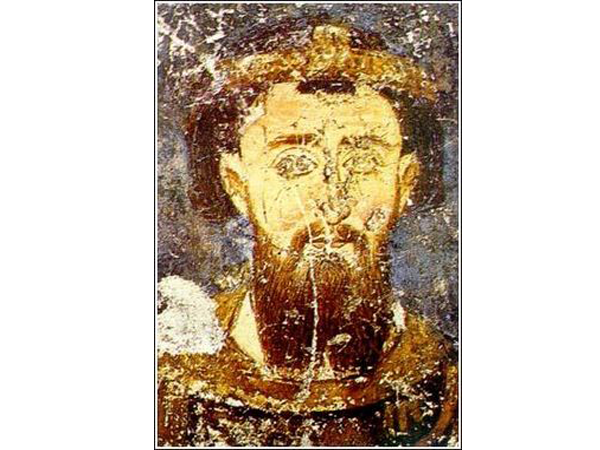
( Exact place and date of birth are unknown )
Stefan Nemanjić was the second eldest son of Grand Prince Stefan Nemanja and Anastasija. His older brother and heir apparent, Vukan, ruled over Zeta and the neighbouring provinces (the highest appanage) while his younger brother Rastko (later known as Saint Sava) ruled over Hum.
The Byzantines attacked Serbia in 1191, raiding the banks of South Morava. Nemanja had a tactical advantage, and began to raid the Byzantine armies. Isaac II Angelus summoned a peace treaty, and the marriage of Nemanja's son Stefan to Eudokia Angelina, the niece of Isaac II, was confirmed. Stefan Nemanjić received the title of sebastokrator.
Heir apparent conflict
In an inscription dated 1195 in the church of St. Luke in Kotor, Vukan is titled as King of Duklja, Dalmatia, Travunia, Toplica and Hvosno.
Saint Sava (Rastko, his brother) and Saint Simeon (Stefan Nemanja, his father), founders of the Serbian Church.
Although Vukan was Nemanja's eldest son, Nemanja preferred to see Stefan II on the Serbian throne mostly because Stefan was married to Byzantine princess Eudokia. It seems that Vukan reacted on this change in succession by declaring himself King of Duklja. Although he assumed a "sovereign" royal title, Vukan remained under his father's authority. On 25 March 1196, Stefan Nemanja summoned a Council in Ras, where he officially abdicated in favour of his second son, Stefan, to whom he bequeathed all his earthly possessions. This decision was not in accordance with the traditional right of primogeniture, according to which Vukan should inherited the throne. This was not accepted lightly by Vukan. Nemanja took monastic vows in the Church of Saints Peter and Paul and adopted the monastic name of Simeon. Simeon subsequently retired to his Studenica monastery and Anastasia retired to the Monastery of the Mother of Christ in Kuršumlija. After numerous pleas by Sava (originally Rastko), Simeon left to the Mount Athos, and joined Sava in 1197 in the Vatopedi monastery. In 1199, the two together rebuilt the ruined Eastern Orthodox Monastery of Hilandar given to the Serbian people by the Byzantine Emperor, which became the heart of Serbian spiritual culture. Simeon died on 13 February 1199.
While Nemanja was alive Vukan didn't oppose Stefan's rule but as soon as Nemanja died, he started to plot against him in order to become Grand Prince. He found aid in Hungarian king Emeric (1196–1204) who at the time fought against the Second Bulgarian Empire and wanted assistance. With the help of Hungarian troops in 1202, Vukan managed to overthrow Stefan, who fled into Bulgaria. Vukan was left to rule Serbia.[1] In an inscription dating to 1202–1203, Vukan is titled as "Grand Župan Vukan, Ruler of all Serbian land, Zeta, maritime towns and land of Nišava".
In return for Hungarian help, Vukan became a Hungarian vassal and promised that he would convert to Catholicism if the Pope would give him the title of King. However, as a Hungarian vassal, Vukan soon got involved in the conflict with Bulgaria. In 1203 the Bulgarian army attacked Vukan, annexing Niš. In the chaos that followed, and using Vukans's sympaties for Catholicism against him, Stefan managed to return to Serbia and overthrow Vukan in 1204 becoming ruler again. Vukan was pushed into his holdings of Zeta.
In the meantime, Bishop Sava (the youngest brother), had success on Mount Athos, founding the cradle of Serbian Christianity. Sava returns to Serbia in the winter of 1205–06 or 1206–07, and intervenes and reconciles his two brothers, taking the remains of his father with him, which he relocates to the Studenica monastery. Stefan II asks him to remain in Serbia with his clerics, which he does, starting a widespread pastoral and educational duty to the people of Serbia. He and Sava founds several churches and monasteries, among them the Žiča monastery.
Vukan continues to rule as titular King in Zeta, and abdicated in ca 1208, when his son Đorđe is mentioned as titular King of Zeta, although in edicts from Studenica dated 1209, he is mentioned only as Great Prince. Vukan seems to have died in 1209 or shortly thereafter.
